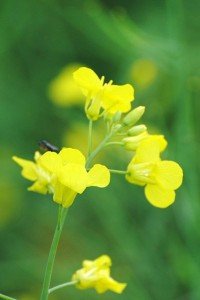American research has shown that genetically modified canola plants grow outside of defined cultivation areas and that the plant’s modified genetic traits persist in wild.
 However, experts note that this is not new and that GM plants have been well documented in the wild previously.
However, experts note that this is not new and that GM plants have been well documented in the wild previously.
The study, published today by the online journal PLoS ONE, reports that genetically engineered canola endowed with herbicide resistance have been found growing outside of established cultivation regions along roadsides across North Dakota. These “escaped” plants were found state-wide and accounted for 80% of the total roadside canola plants sampled.
GM crops – canola or otherwise – are not commercially grown in New Zealand, but are the subject of scientific trials. Australia has established commercial GM canola crops.
You can read the full open access article here.
The authors also found that the escaped plants could hybridize with each other to create novel combinations of transgenic traits.
The authors argue that their result, more than 10 years after the initial release of genetically engineered canola, “raises questions of whether adequate oversight and monitoring protocols are in place in the U.S. to track the environmental impact of biotech products.”
However, they also note that biotechnology can provide important tools to feed the rapidly growing population. “We must safely engage all tools available to us to advance food, fuel and fiber alternatives as modern agriculture rises to the challenges of the next decade,” they conclude.
Below is expert commentary collected by our friends at the Australian Science Media Centre. If you would like to speak to a NZ expert please don’t hesitate to contact the NZ SMC (04 499 5476; smc@sciencemediacentre.co.nz)
Professor Peter Langridge is CEO of the Australian Centre for Plant Functional Genomics (ACPFG) at the University of Adelaide, comments:
“There is no great surprise from this study. Canola is known to establish along roadsides in many parts of the world and the GM canola is no different from normal canola in this respect.
“Generally crops are not invasive and rarely become weeds because they have been bred and selected to grow in highly managed farm environments. Many key traits needed for wild plants, and particularly weeds, have been largely removed from our crops – such as seed dormancy and shattering (seed dispersal). This limits the likelihood of crop species becoming weeds in natural ecosystems.
“However, roadsides provide a special environment where crop species often flourish due to the extra water from runoff from the roads and regular mowing. This is why we often see wheat, barley and canola growing alongside roads.
“It was always expected that the GM canola would behave in the same way and, as the area sown to GM canola grew, the incidence of roadside populations would expand. This does not present an environmental or safety problem for the community.
“The GM canola has been rigorous evaluated and presents no health issues and the roadside populations are essentially the same as the non-GM roadside populations. However, councils that use herbicides to control weeds along roads, will need to ensure they use the appropriate herbicides to also control the GM canola.”
Professor Rick Roush is Dean of the Melbourne School of Land and Environment at the University of Melbourne comments:
“This paper is unremarkable and not at all surprising. The authors have presented no evidence that GM canola is any more weedy or problematic than non-GM canola, or that any harms whatsoever have resulted.
“All of the results documented in the paper have been made elsewhere, and repeated now in the US state of North Dakota.
“The survey was explicitly only for roadsides and neighbouring highly disturbed habitats.
“These are not important to biodiversity, and no claims were made for adverse environmental impacts on roadsides or anywhere else.
“Herbicide resistance in canola is of no consequence if the canola is not sprayed, and that’s not likely in habitats of environmental significance.
“Canola has been known to persist along roadsides in Europe, North America and Australia for decades, including French and Canadian research from 2001 and 2003, as cited in the paper.
“We can expect to find GM canola growing on roadsides in NSW, Victoria and Western Australia, alongside non-GM canola, with no more consequence than brightening the roadsides with yellow during their flowering.
“Hybridisation between canola lines of different GM and non-GM herbicide resistances was documented by Dr Linda Hall in Canada more than 10 years ago, and is still not a problem of any sort in Canada.
“Many other feral crop plant species can be found on roadsides, including lucerne, without causing harm. The more important threats come from weeds such as wild radish and escaped garden plants, such as Pattersons Curse, and many more recent but not yet as well-known weeds.